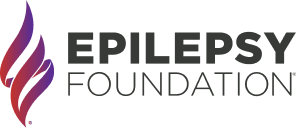Epilepsy and ADHD

Attention-deficit/hyperactivity disorder (ADHD) occurs more frequently in people with epilepsy than in the general population.
- Children with ADHD have an increased risk of seizures, with approximately 14% of children with ADHD developing seizures. ADHD is the most common co-occurring disorder in children with epilepsy. Studies suggest that 30 to 40 out of 100 children with epilepsy have ADHD in contrast to 7 to 9 out of 100 children in the general population who have ADHD.
- Researchers have also found nearly 20 in 100 adults with epilepsy may also have ADHD, whereas 2.5 to 4 out of 100 adults have the disorder in the general population.
About ADHD
There are three types or “presentations” of ADHD:
- Predominantly inattentive
- Predominantly hyperactive-impulsive
- Combined
Inattentive

People with ADHD that is mostly inattentive typically have trouble with:
- Focusing on details or not making careless mistakes
- Difficulty paying attention for a period of time
- Listening
- Following instructions
- Organizing
- Doing tasks requiring sustained mental effort
- Keeping track of belongings
- Not getting easily distracted
- Remembering things while doing daily activities
Hyperactive-Impulsive
People with ADHD hyperactive-impulsive presentation have symptoms such as:
- Constant fidgeting with their hands or feet or squirming in their chair
- Difficulty remaining seated
- Run about or climb excessively in children; extreme restlessness in adults
- Difficulty engaging in activities quietly
- Act as if driven by a motor
- Excessively talkative
- Tendency to blurt out answers before questions have been completed
- Difficulty waiting or taking turns
- Interrupts or intrudes upon others
Combined
In the combined presentation of ADHD, people have both inattentive and hyperactive/impulsive symptoms.
About Epilepsy
A person is considered to have epilepsy if they meet any of the following conditions:
- At least two unprovoked (or reflex) seizures occurring greater than 24 hours apart.
- One unprovoked (or reflex) seizure and a probability of further seizures similar to the general recurrence risk (at least 60%).
- Diagnosis of an epilepsy syndrome.
Epilepsy is considered resolved for people who had an epilepsy syndrome that occurred at only a specific age and are now past that age. Epilepsy also is said to have resolved for people who have been seizure-free for 10 years, with no seizure medicines for the last 5 years.
Epilepsy is actually considered a family of disorders with different types of seizures and syndromes. There is a wide diversity of challenges faced by people with epilepsy and their families. Some people and their families may be faced primarily by challenges of seizures. Yet many have associated problems with learning, mood, and behavior that affect quality of life more than the seizures. Attention-deficit disorders are one of these probems seen rather frequently in people with epilepsy.
Treating both ADHD and Epilepsy
Treating someone with both epilepsy and ADHD can be challenging. Some seizure medicines can make ADHD symptoms worse. Some people are concerned that stimulant medication, often used to treat ADHD, can trigger seizures.
A review of research on ADHD in people with epilepsy showed that stimulant medications can effectively treat symptoms of ADHD, but the medicine’s effect may be lower than what is seen in children with ADHD without epilepsy. The risk of increased seizure frequency appears to be minimal with stimulant treatment. However, people should be warned of the possible risks and closely monitored for increased seizures. The researchers also pointed out the studies that showed this minimal risk were limited by the small amount of people participating in each study.
When people have both ADHD and epilepsy, it’s critical to work with health care professionals knowledgeable about epilepsy, behavior, and thinking. A treatment plan that addresses both the epilepsy and ADHD should be developed. The health care team needs to consider the following:
- Symptoms of ADHD may complicate the diagnosis of epilepsy, as they may be mistaken for seizures.
- If a person is having seizures, treating these first should be the priority. If seizures can be controlled, some symptoms thought to be due to ADHD may improve.
- Tracking how symptoms progress or change on treatment will help decide next steps.
- When symptoms of ADHD remain separate from seizures or in a person with controlled epilepsy, the ADHD should be treated. Reducing symptoms of ADHD may lessen stress and improve the person’s ability to manage his or her medication and life challenges.
- Treatment plans are ongoing and should be reviewed at least annually to make sure the treatment is working and to adjust as needed.
Treatment options for ADHD include the following:
- Behavioral or cognitive behavioral therapy
- Medication
- Skills training
- Coaching
- School supports and accommodations
Interventions should be tailored to each person to help control symptoms, cope with both disorders, improve overall psychological well-being, and manage social relationships. Family involvement is important, too, in many of these therapies. Both ADHD and epilepsy affect the family. The family’s understanding of, and confidence in managing, the impact of both disorders should be addressed in the treatment plan.
Learn More
- For more information on attention-deficit/hyperactivity disorder, visit the National Resource Center on ADHD, a program of Children and Adults with Attention-Deficit/Hyperactivity Disorder (CHADD).
- Learn more about epilepsy and seizures.
Resources
Epilepsy Centers
Epilepsy centers provide you with a team of specialists to help you diagnose your epilepsy and explore treatment options.
Epilepsy Medication
Find in-depth information on anti-seizure medications so you know what to ask your doctor.
Epilepsy and Seizures 24/7 Helpline
Call our Epilepsy and Seizures 24/7 Helpline and talk with an epilepsy information specialist or submit a question online.
Tools & Resources
Get information, tips, and more to help you manage your epilepsy.


